Exploring the great outdoors is a wonderful privilege but for us to truly be immersed in nature, we ideally need to be spending at least one day and a night outdoors, preferably backpacking for longer than that.
When backpacking or camping for multiple days, you absolutely need a backpacking water filter to filter and/or purify your drinking water, if sourced from streams or lakes.
It can be tempting to drink unfiltered water straight from a crystal-clear lake or a fast-flowing stream but you should exercise caution, as even the most beautiful clear water sources could potentially be contaminated and end up making you sick.
This best backpacking water filters buyer’s guide is split into two distinct parts:
PART 1 lists the best water filtration systems and purifiers for camping and backpacking, along with the key features that make them good at their job, typical situations when you may want to use them, and also their pros & cons.
PART 2 is my complete buyer’s guide which will have you a water filter and purifier expert by the time you finish reading it. I explain things like the difference between filtered, purified, and distilled water, the different types of filters and purifiers available, the benefits/disadvantages of each type, and finally why you may want to choose one over another.
The best backpacking water filters & purifiers
1. Grayl UltraPress Ti Purifier (Titanium Edition) | BEST OVERALL
- Type: Bottle press filter
- Removes/destroys: Protozoa, Bacteria, and Viruses
- Cost: $199.95 at grayl.com
- Capacity: 16.9 oz.
- Throughput: 3L per min
- Weight: 14.1 oz
If you’re looking for the best backpacking water filter and purifier rolled into one, the Grayl UltraPress Ti is it.
It shares many great features with the Grayl Geopress, below, including its ability to purify water to exclude all waterborne pathogens (including viruses and bacteria), chemicals, heavy metals, and particulates like microplastics – all without the need for batteries or other power.
However, the Grayl UltraPress Ti is the best backpacking water filter on this list because it can do even more than filter your water.
Because it’s made from Titanium, the UltraPress Ti can be used as a cooking pot with your camp stove (such as the ultralight, compact Grayl Titanium Camp Stove), and at a tiny weight of 14.1 oz, it’s even more lightweight to carry than the lightweight Grayl Geopress.
Due to its slender diameter, the UltraPress Ti will also fit into the majority of backpack side pockets, and it has ergonomic handles on the side and lid for ease of portage.
2. Grayl Geopress Water Purifier Bottle | RUNNER UP
|
|
$99.95 | See Deal |
|
|
$99.95 | See Deal |
|
|
See Deal |
- Type: Bottle press filter
- Removes/destroys: Protozoa, Bacteria, and Viruses
- Cost: $89.95 at grayl.com and Amazon.com
- Capacity: 24 oz.
- Throughput: 8 seconds for 24 oz. (5L per min.)
- Weight: 15.9 oz.
If you loved the sound of the Grayl UltraPress Titanium edition, above, but not so much the price tag, then the Grayl Geopress could be just what you’re after.
The Grayl Geopress Water Purifier Bottle provides protection from all waterborne pathogens (including viruses and bacteria), chemicals, heavy metals, and even particulates like microplastics.
It is one of the best water filtration systems and water purifiers for camping and backpacking that we’ve tested.
The Geopress water purifier is also lightweight, easy to use, and can purify 24 ounces of dirty water in just 8 seconds, which is incredible.
For those who need to be able to filter large amounts of water while camping, or provide friends with clean drinking water while backpacking, this purifier can clean 5 liters of water in just 1 minute – that’s pretty amazing.
The Geopress Water Purifier can produce 250 liters (65 gallons) of clean drinking water with each replaceable water filter/purifier cartridge, and you can buy spare purifier cartridges for only $29.95 each which I recommend doing just in case it gets compromised or reaches the end of its lifespan during a long backpacking trip.
For the curious among you, 250 liters is roughly 350 ‘presses’ or uses of one filter/purifier cartridge – that number will go up and down slightly, depending on how silty the water you filter is.
When press time increases to around 30 seconds, that’s when you know it’s time to replace your purifier cartridge.
3. Katadyn BeFree 1L Collapsible Bottle | RUNNER UP
|
|
$39.95
3
new
from $39.95
|
See Deal |
|
|
$44.95 | See Deal |
- Type: Collapsible squeeze bottle filter
- Removes/destroys: Protozoa, Bacteria
- Cost: $44.95 at Amazon.com
- Capacity: 33.8 oz (1 liter)
- Throughput: 2L per minute
- Weight: 2.3 oz.
The Katadyn BeFree water filter is one of the best backpacking water filters due to its ease of use, small packable size, and low weight of only 2.3 ounces when empty.
This squeeze water bottle filter also has a very generous capacity of 1 liter when full which gives you plenty of drinking water until you find your next water source. Learn more about squeeze water filters guide below.
We are really impressed by the speed at which it filters water too, with the capability of filtering 2 liters of water per minute, you can use this filter to create safe drinking water for the whole camp in a matter of minutes simply by decanting your filtered water into other bottles or bladders.
This Katadyn water filter uses a soft flask / collapsible bottle design which makes it very malleable when not 100% full, meaning you can fit the bottle in all sorts of interesting shaped spaces.
So, if you have a slim side pocket on your hiking daypack or backpacking backpack then you would have more luck squeezing this in than a 24oz hard bottle.
Short of using a straw filter, this is one of the most portable and best water filter systems out there because it’s so lightweight, very packable, stores up to 1 liter of filtered water, and is very reasonably priced.
4. Lifesaver Wayfarer | COMPACT ALL-ROUNDER
- Type: Portable pump filter that purifies water
- Removes/destroys: Viruses, Bacteria, Cysts, and certain chemicals and heavy metals
- Cost: $104.95
- Capacity: Purifies up to 5,000 liters / 1,320 US gallons
- Throughput: Initial flow rate 1.4L per min
- Weight: 11.4 oz
When it comes to a compact, lightweight, and reliable backpacking water purifier, the Lifesaver Wayfarer punches well above its weight. As their smallest and lightest system yet, it’s pocket-sized but robust.
It’s a great companion for the adventurous soul who won’t let microbiologically contaminated water stand in the way of a good hike.
Using ultrafiltration technology, the Wayfarer effectively filters out viruses, bacteria, cysts, and parasites making it a full-on purification system. It even goes the extra mile to reduce chemicals and heavy metals, thanks to its replaceable activated carbon disc, and the taste is also improved.
The safety levels are also very impressive; as it meets the NSF Protocol 231 based on U.S. EPA recommendations.
But what sets the Lifesaver Wayfarer apart is its FailSafe technology. Once the filter membranes are blocked, water cannot pass through, keeping you safe from contaminants – smart!
Weighing only 11.4 oz, the British-made Wayfarer includes a 4.2ft scavenger in-hose and a 1.6ft out-hose, both designed for ease of use, and a rotating pump handle compatible with both left and right-handed users. Moreover, it’s BPA and BPS free, which is great for your health and the environment.
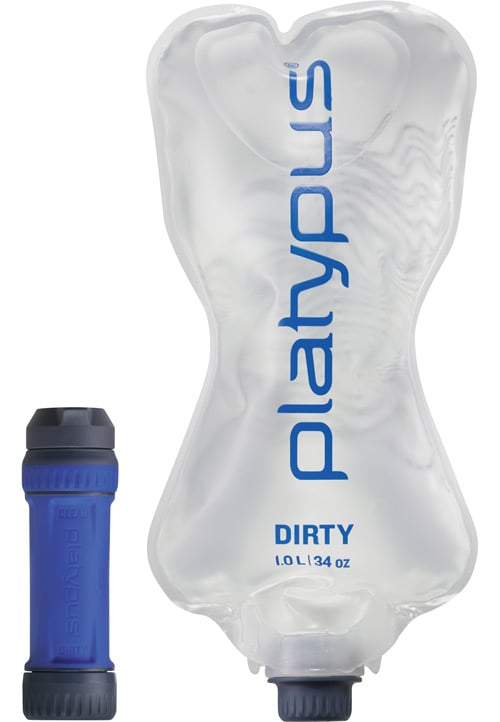
5. Platypus QuickDraw Microfilter System | MOST VERSATILE
|
|
$58.19
1
new
from $58.19
|
See Deal |
|
|
$49.95
out of stock
|
See Deal |
|
|
$29.93
out of stock
|
See Deal |
- Type: Squeeze filter
- Removes/destroys: Protozoa, Bacteria
- Cost: $39.95 at Amazon.com | platy.com
- Capacity: 34 oz (1 liter)
- Throughput: 3L per minute
- Weight: 3.6 oz. (filter + reservoir)
The Platypus Quickdraw is one of the best portable water filtration systems out there as it’s super packable, easily stored, and can filter as much water as you choose to attach to the filter device, or alternatively you can keep filling up the provided 1-liter reservoir as the throughput is so fast – 3L per minute. Learn more about squeeze filters in my guide below.
The cartridge which houses the hollow fiber filter only weighs 2.2 ounces and can easily be stored in your backpack, even with the reservoir which can be conveniently rolled up around the cartridge when empty.
We like that the exterior of the cartridge is made with a durable thermoplastic elastomer (TPE) which is soft and grippy to the touch, even when wet – something that has been overlooked on some competitor squeeze filters that look similar to the Platypus QuickDraw.
The included QuickDraw reservoir is pretty special too; it uses a proprietary tri-layer film that is taste-free, durable, and features a wide mouth and handle so that you can easily fill it up at most water sources.
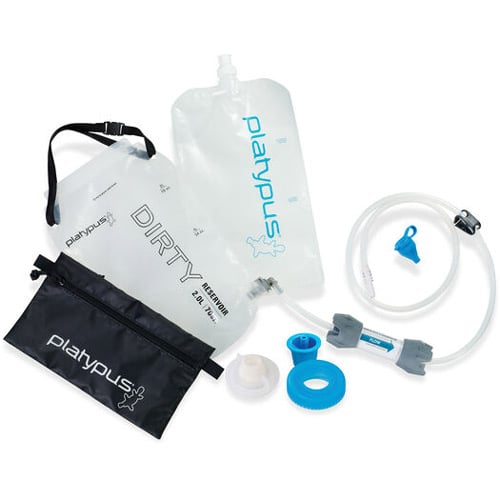
6. Platypus GravityWorks Water Filter | BEST GRAVITY WATER FILTER
|
|
$149.99
1
new
from $149.99
|
See Deal |
|
|
$125.95
out of stock
|
See Deal |
|
|
$59.93
out of stock
|
See Deal |
- Type: Gravity filter
- Removes/destroys: Protozoa, Bacteria
- Cost: $99.95 at Amazon.com | platy.com
- Capacity: 67 oz (2 liter) | 4L / 6L also available
- Throughput: 1.5L per minute
- Weight: 10.9 oz.
Platypus GravityWorks water filter systems are available in 2.0L, 4.0L, or 6.0L capacities, and are excellent for those who prefer to be able to filter lots of water with minimal effort.
Gravity water filters like Platypus’ GravityWorks are excellent for keeping the whole group hydrated while camping out overnight because of their large capacity – they’re also great camping water filters for the same reason. Learn more about gravity filters in our educational guide below.
The Platypus GravityWorks water filter system uses hollow fiber filter technology which is how it is able to filter water so quickly when compared to some other gravity filters.
Although this system may look a little more complicated than other water filters, it’s super easy to use.
All you have to do is fill the dirty collection reservoir (labeled ‘dirty’), hang it above the clean Platy bottle, and simply let gravity carry the water through the filter – no pumping, pressing, or squeezing is required.
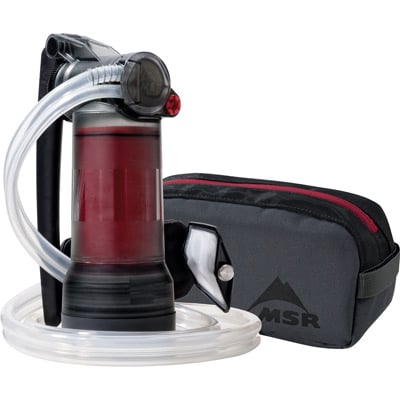
7. MSR Guardian Purifier | BEST PUMP FILTER/PURIFIER
|
|
$370.00
11
new
from $370.00
|
See Deal |
|
|
$389.95 | See Deal |
|
|
$389.95 | See Deal |
- Type: Pump filter/purifier
- Removes/destroys: Protozoa, Bacteria, viruses
- Cost: $349.95 at Amazon.com | msrgear.com
- Capacity: As much as you need
- Throughput: 2.5L per minute
- Weight: 1lb 1.3oz
The MSR Guardian pump purifier is a fast way to filter lots of water for groups, even from the smallest of water sources, as you can place the inlet hose in very shallow water.
The MSR Guardian has an impressive throughput of around 2.5L per minute, depending on your arm strength and willingness to continuously pump. Learn more about pump filters in our guide below.
What’s great about this MSR water filter and purifier, is that it filters out dirt and silt really well, and also purifies your water (blocking harmful viruses too).
Unlike conventional hollow-fiber filter technology, the advanced medical-grade fibers in the Guardian pump blocks viruses, which is something that most other hollow-fiber filters can’t do.
The pump also has an auto back-flushing feature which means you won’t have to manually clean the filter.
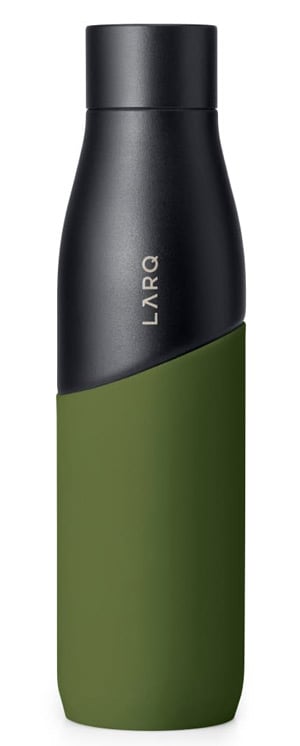
8. LARQ Self Cleaning Water Bottle | BEST UV PURIFIER
- Type: UV-C Purifier
- Removes/destroys: Protozoa, bacteria, and viruses
- Cost: $78 at livelarq.com | Amazon.com
- Capacity: 24 oz | 32 oz
- Throughput: 1min | 3mins in Adventure mode cycle
- Weight: 10.7 oz | 12.5 oz (bottle size dependent)
For a detailed look at the LARQ Bottles, read my reviews: LARQ Bottle Movement Review / LARQ Bottle Filtered Review: A Water Filter With Benefits / LARQ Bottle Review (insulated version) / LARQ at-home water filter pitcher review
Having a water bottle, like the LARQ bottle, that automatically purifies the water you put in it and also cleans itself while backpacking, is pretty awesome.
The battery life of the UV Light cap will last around a month so if you’re planning a backpacking trip for anything less than that, then this UV water purifier is an excellent choice.
BIG NEWS: LARQ now has a portable water filter bottle that can be used in conjunction with their PureVis UV-C Purifier cap to give you the ultimate water purification/filtration system while backpacking. Read all about it HERE.
The LARQ self-cleaning water bottle is also pretty lightweight for a stainless steel bottle, and because the purifying cycle runs automatically periodically (or by tapping the top button) – it ensures your bottle doesn’t get stinky like a traditional water bottle will.
It does this by also killing bacteria that enter the bottle after taking a swig of water. Learn more about UV water purifiers in our guide below.
Although UV water purifiers don’t filter out silt and sediments, they do an excellent job of killing more harmful contaminants than a filter can, as they also kill viruses as well as protozoa and bacteria.
So when you need to fill up the LARQ bottle on a backpacking trip, I’d recommend finding a clear water source that is colorless, and even better, running water if you can find it. Another option would be to pre-filter the source water through a cloth, or a tight-knit shirt for example.
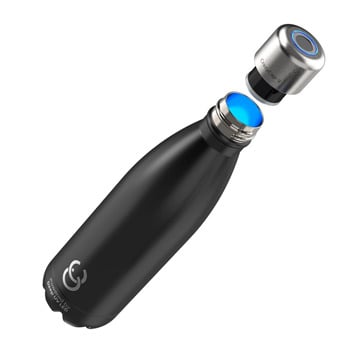
9. CrazyCap 2 Water Purifier | BEST UV PURIFIER [RUNNER UP]
- Type: UV-C Purifier
- Removes/destroys: Protozoa, bacteria, viruses
- Cost: $69.95 at thecrazycap.com | Amazon.com
- Capacity: 12oz | 17oz | 25oz
- Throughput: 1min | 2.5mins with ‘Crazy’ cycle
- Weight: 12.6 oz (17oz bottle size)
Watch my review on YouTube: CrazyCap 2 Water Purifier Review
Similar to the LARQ bottle above, the CrazyCap 2 is a UV-C light purifier that will kill protozoa, bacteria, and viruses.
This water purifier can be used on various bottle designs, however, which makes it very versatile.
The bottle that comes in the package is insulated which means it will keep your water cold for 24 hours, this is very nice to have if backpacking during the hot summer months.
Insulated bottles do add a little extra weight to your backpack, however, so you’ll need to decide how important cold water is when factoring in weight.
This UV water purifier also runs various automatic purifying cycles throughout the day which keeps the bottle stink-free and clean during your backpacking trip.
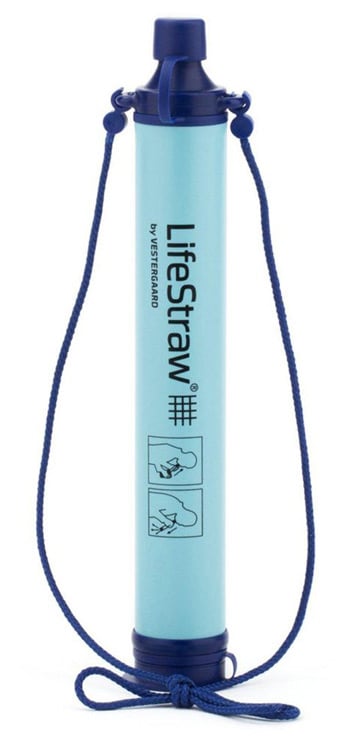
10. Lifestraw Personal Water Filter | LIGHTEST FILTER
|
|
$16.13
7
new
from $14.97
|
See Deal |
|
|
$24.95 | See Deal |
- Type: straw water filter
- Removes/destroys: Protozoa, Bacteria
- Cost: $29.95 at Amazon.com
- Capacity: 0
- Throughput: As fast as you can suck up water
- Weight: 2.0 oz.
The Lifestraw personal water filter is a great option for backpackers who like to adventure with minimal lightweight gear – it’s the most portable water filter for sure.
This straw water filter is so small and light that it can be worn around your neck (with the included removable lanyard) for quick easy access when needed, or stashed in your backpack without really noticing it’s there.
It’s worth noting that you don’t get any way of storing filtered water with the Lifestraw person water filter, so this is mostly going to suit those who are backpacking for short amounts of time or know there to be plenty of water sources along the route.
For those of you planning longer backpacking trips, I would recommend a water filter that also has the ability to store filtered water – that way you won’t get in a situation where you desperately need water when there’s no water source in sight.
Consider buying the Grayl Geopress or Katadyn BeFree water bottles filters in such a case.
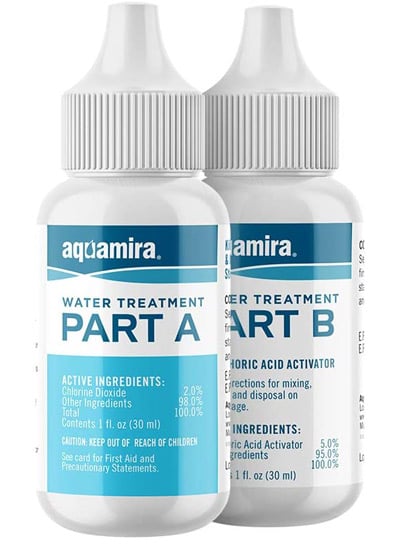
11. Aquamira Treatment Drops | BEST CHEMICAL PURIFIER
- Type: Chemical water treatment
- Removes/destroys: Protozoa, Bacteria, viruses
- Cost: $14.95 at Amazon.com
- Capacity: treats up to 30 gallons
- Throughput: 1L takes at least 20 mins to purify
- Weight: 3.5oz
Aquamira water treatment drops are a really convenient way to purify your water and great to have in your backpacking backpack in case your primary water filter/purify breaks down.
The active ingredient in these drops is Chlorine Dioxide which does not contain Iodine or Chlorine, and it works by releasing nascent oxygen, a highly active form of oxygen, which is a strong oxidant and a powerful germicidal agent.
As with everything in life, however, there are some caveats to chemical water treatments. Learn more about chemical water treatments in our guide below.
BUYER’S GUIDE | How to choose a water filter or purifier
It’s a pretty well-known fact that if you don’t have access to clean drinking water, you can only survive for around 3 days – so just imagine if you had an emergency in the wilderness, or were to somehow find yourself lost without a way to communicate your location to friends, or rescue services.
Well, there’s no need to worry about these risks, when you prepare yourself correctly. This guide will help ensure you are prepared for such an occasion, and to generally keep you in good health through proper hydration while hiking, backpacking, trail running, or camping in the great outdoors.
We always recommend setting off on your hiking or backpacking adventure with a full flask or bladder of water, if you’re hiking for just a day then the chances are this won’t be enough for your time spent on the trails.
A bladder may last longer than a water bottle or flask but if you intend to at least spend one-night camping as part of a longer backpacking adventure then you definitely need to invest in one of the above-listed water purification systems or filters.
This backpacking and camping water filter (and purifier) buyer’s guide will help you choose the best water purification system for your travel/backpacking/camping requirements.
There are different types of systems (and also brands) that you need to be aware of, but there’s not really a ‘catch-all’ water filter system that will do everything just the way you want.
Although, the Grayl Geopress Purifier does come as close as it gets. The reason there’s no real one-size-fits-all so to speak is that there are pros and cons to each system based on what you need from your water filtration system, which I’ll get into a bit more in just a moment.
Filtered VS purified VS distilled VS boiled water
Before I explain the different types of water filtration systems and water purifiers available and the various methods for each one of them, here’s a quick rundown of the differences between filtered, purified, distilled, and boiled water, as knowing their definitions will likely help you choose the best backpacking water filter for you.
WHAT IS FILTERED WATER?
Filtered water is the result of passing water through a filter (physical element). This water will have had waterborne protozoa and bacteria removed from it, but not viruses.
WHAT IS PURIFIED WATER?
Purified water is water that has had protozoa, bacteria and viruses killed or removed. This is a higher level of defense than a water filter but it’s important to note that not all water sources have viruses in them, in which case a filter would be a sufficient method of creating safe drinking water.
WHAT IS DISTILLED WATER?
Distilled water is a type of purified water that has had contaminants and minerals removed. It is created by boiling water into vapor and condensing it back into liquid form in a separate container.
Impurities in the original water that do not boil below or near the boiling point of water remain in the original container.
I don’t list any water distillers in this post as they are generally large, heavy, can take a long time to make clean water, and are just not practical for backpacking.
WHAT IS BOILED WATER
This is, quite simply, any water that has been heated to 100°C or 212°F (the boiling point for water).
Boiling water in the wild requires a metal pot, and a means to heat the water, like fire, or a gas burner for example.
Boiling water is not the fastest or most efficient way to create drinking water in the wilderness but it’s a valuable survival skill.
The best way to do this while backpacking is to use a lightweight backpacking stove – these stoves are also the best way to cook food while on the trails.
Water treatment techniques and their advantages/disadvantages
There are 4 viable treatments that can be used to create safe drinking water while backpacking: filtration, purification, chemical water treatments, or simply boiling your water.
However, each one of these water treatment techniques has been innovated on, bringing a plethora of smart filtration and purification systems to outdoor enthusiasts.
Each one of these water filtration systems, however, have their advantages and disadvantages over other systems explained in more detail below.
1. WATER FILTRATION SYSTEMS TO CHOOSE FROM
Water filtration systems generally use activated carbon, which comes in the form of powdered activated carbon (PAC) or granular activated carbon (GAC).
PAC has a smaller particle size than GAC and is typically more efficient at removing a wide range of impurities from the water. Activated carbon will also help remove any unwanted taste from unfiltered water.
There are however multiple ways to utilize a filter within a water filtration system, read on to learn about them.
→WHAT ARE WATER FILTERS | HOW THEY WORK
Straw filters like the Lifestraw personal water filter, for example, are such great trail companions for those who like to explore fast and light.
They are very easy to use, just stick it in the water source, get down low, and suck the water through the straw and let the filter do the work for you.
There are plenty of advantages and disadvantages of a water filter system like this.
ADVANTAGES INCLUDE:
- Water filter straws are extremely lightweight and compact making them very packable in hydration packs / running vests, backpacks or hiking daypacks.
- Water is filtered as you suck, so drinking water is instantly available.
- Tend to be cheaper than other filter systems.
DISADVANTAGES INCLUDE:
- Drinking water is only available when you’re at a water source – you can’t store the filtered water for later
- Leading on from my first point, it’s not a great solution for more than one person.
- They can be awkward to use, especially for the older generation as you need to get very low to the water source to use it.
- Don’t generally remove chemicals, lead, or viruses.
→ WHAT ARE GRAVITY WATER FILTERS | HOW THEY WORK
Gravity water filters tend to be reservoirs that you fill with water from a source.
Once full you need to find a high place (like a tree branch) to hang it up, and then you simply wait for the water to filter through the system.
ADVANTAGES INCLUDE:
- Easy to use once you have found a place to set it up, as gravity literally does all the work for you.
- Gravity bags can filter large amounts of water – this makes them good for camping and big groups.
- Portable and lightweight, as the bag, can be rolled up when empty, and the filter element is usually pretty small.
DISADVANTAGES INCLUDE:
- Finding somewhere to hand the gravity water bag can be a challenge depending on where you are camping.
- Not the best water filter if you’re looking to filter water quickly. It’s a slower process than filters requiring pumping, pressing, or squeezing.
- The water reservoir is essentially a bag so it can be a challenge to fill up, unless you have a deep enough water source, at least 3 inches is preferable.
→ WHAT ARE PUMP WATER FILTERS | HOW THEY WORK
Pump water filtration systems require a bit more effort than other systems but they do filter water quickly and effectively.
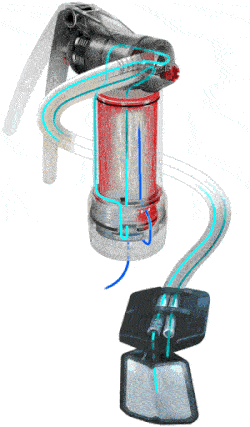
To get started, place the intake hose into your questionable water source, and the outlet nozzle into a clean drinking water container, like a water bottle for example – then start pumping.
Some pump water filters, like the MSR will attach directly to your water bottle eliminating the need for an extra hose (the outlet one).
ADVANTAGES INCLUDE:
- You can create as much filtered water as you would like – keep pumping until al your bottles are full.
- Works well in shallow water sources.
DISADVANTAGES INCLUDE:
- Pumping can be hard work, and this only gets more challenging as the filter element nears the end of its lifecycle.
- Pump water filters can be bulkier than alternative backpacking water treatment systems as you have to carry the hose(s) with you. The actual filter cylinder itself can be quite small however.
→ WHAT ARE PRESS WATER FILTERS | HOW THEY WORK
A press filter system allows you to collect water from its source into a container, like a bottle, and then push the filter through the dirty water, usually with a great amount of pressure due to the filter being so granular.
Once filtered, the clean drinking water is stored in the bottle without ever getting contaminated by the original source water.
The Grayl Geopress water purifying bottle is a great example of a press water filter.
ADVANTAGES INCLUDE:
- It’s fast! A good press water filter like the Grayl Geopress purifier can treat 24 oz of water in around 8 seconds.
- Because it’s fast, you can use one multiple times, and fill up a camp reservoir for family or friends very quickly.
- In a bottle format, you can conveniently store purified water once pressed.
- Lightweight, robust, and simple to use.
DISADVANTAGES INCLUDE:
- Pressing can get tough when the filter nears the end of its life cycle (around 350 presses), that’s when you replace the filter element.
→ WHAT ARE SQUEEZE WATER FILTERS | HOW THEY WORK
These come in various shapes and sizes but generally tend to be a filter that attaches to a bottle or a small reservoir.
You fill the bottle or reservoir up from your source, and then squeeze the water (or suck in some cases) through the filter directly into your mouth, or into an alternative water storage vessel.
ADVANTAGES INCLUDE:
- Easy to use and water is filtered very quickly.
- Can be used as a straw water filter or squeeze filter, with the correct attachments.
- Tend to be small, lightweight, and reasonably priced.
DISADVANTAGES INCLUDE:
- Water quantity is limited by the bottle or reservoir you’re using.
- An additional squeezable reservoir or bottle is required to filter your water.
→ WHAT ARE BOTTLE WATER FILTERS | HOW THEY WORK
Bottle water filters are pretty great because of how simple they are to use. You simply fill it up and then drink your water as it passes through the filter that’s situated near the bite valve.
Offering fill-and-sip simplicity, these bottles have built-in filtration or purification elements.
Some bottles like the Grayl Geopress, which uses a press mechanism can even purify your water (not just filter it).
There are other bottles that can purify water using a UV light too, like the very clever LARQ Self Cleaning water bottle which you can read more about in our detailed review.
ADVANTAGES INCLUDE:
- Treatment is easy and water is quickly drinkable.
- They tend to be lightweight and cost less than pump and gravity water filters.
DISADVANTAGES INCLUDE:
- Water quantity is limited by bottle size you have but you can always fill the bottle back up at the next water source.
2. WATER PURIFICATION SYSTEMS TO CHOOSE FROM
→ WHAT ARE PRESS WATER PURIFIERS | HOW THEY WORK
These work the same way as press water filters mentioned above but they purify water, which means they filter out water-borne viruses too.
→ WHAT ARE ULTRAVIOLET LIGHT (UV) PURIFIERS | HOW THEY WORK
UV Light purifiers are a very clever and effortless way to purify your water.
There are two methods for using UVC lights, the first one being a UV pen/stick, like the SteriPEN UV water purifier, which you activate with a button and then stir your water with. This process can take up to a minute to complete.
Another option is a UV water filter bottle which has a UV purification module built into its lid.
The LARQ UV Water purification bottle is a great example of this (reviewed here), and an alternative option is the CrazyCap 2.0 UV Water Purifier reviewed on our YouTube channel here.
ADVANTAGES INCLUDE:
- Treatment is very easy to do, and fast to complete.
- No filters to clean.
- A very convenient and thorough way to purify water while backpacking.
DISADVANTAGES INCLUDE:
- Batteries are required for them to operate.
- Silty or cloudy water can reduce effectiveness, requiring a pre-filter of some sort.
- Multiple treatments will be required to produce large quantities as UV light will only pass through so much water.
→ WHAT ARE GRAVITY WATER PURIFIERS | HOW THEY WORK
These work the same way as gravity water filters mentioned above but they purify water too, which means they filter out water-borne viruses via a purifying element.
→ WHAT ARE PUMP WATER PURIFIERS | HOW THEY WORK
These work the same way as pump water filters mentioned above but they purify water too, which means they filter out water-borne viruses via a purifying element.
3. CHEMICAL WATER TREATMENTS TO CHOOSE FROM
Like all true water purification systems, chemical water treatments like tablets or drops will kill protozoa, bacteria, and viruses.
This method of iodine-based or chlorine-based purification is very simple – just add the tablets or drops, as per the product’s instructions, and wait.
ADVANTAGES INCLUDE:
- Easy to use.
- Very cheap, small and weigh hardly anything.
- A convenient backup in case your main purifier has a fault in the field.
DISADVANTAGES INCLUDE:
- Purification can take 30 minutes to 4 hours, even longer in cold conditions.
- Chemical water treatments can leave a bit of an unpleasant taste.
- Pregnant women shouldn’t use Iodine products – which begs the question, maybe no one should. Chemical water treatments would be a last resort backup method for me.
4. BOILING YOUR WATER
An effective method to create safe drinking water is still a perfectly viable way to purify your water.
You do however need to ensure you have 3 vital items with you while backpacking in order to boil your water: a backpacking stove, a metal pot, and fuel for the stove.
If you’re intending to backpack for more than a night, you really need to be carrying a stove with you anyway.
Remember to boil your source water for 1 minute, or for around 3 minutes if you are backpacking above 6,500 feet of elevation, and if the water is murky, try passing it through tight-knit clothing of some sort.
ADVANTAGES INCLUDE:
- Can be used for pretty much any water source.
- If your filter/purifier breaks, this is an excellent method to create drinking water.
DISADVANTAGES INCLUDE:
- Takes a bit of effort to boil water, and it will run through valuable fuel.
- Not the best-tasting water.
- Takes time to prepare and boil the water, including time to wait for the water to cool down.
I hope you enjoyed this guide to the best backpacking water filters, and how to choose the best one for you! If you have any questions, please ask me in the comments below.

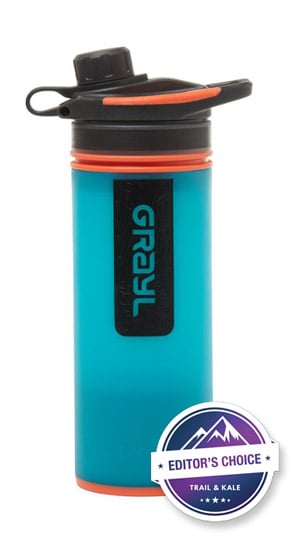









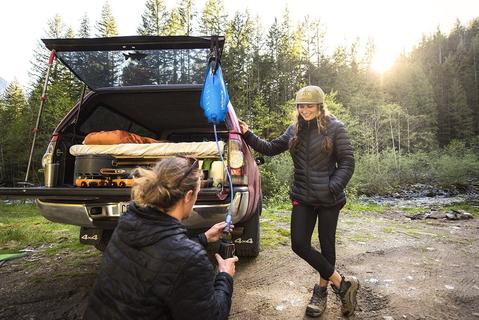

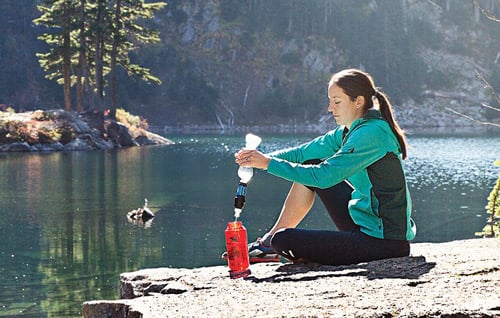





Not many if anyone can afford a water filter at over £300.